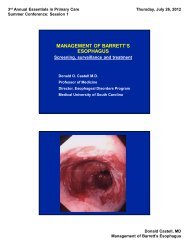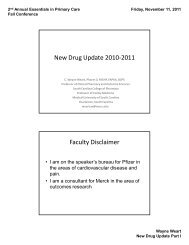144 SEBORRHEIC DERMATITIS SECTION 8 PAPULOSQUAMOUS ...
144 SEBORRHEIC DERMATITIS SECTION 8 PAPULOSQUAMOUS ...
144 SEBORRHEIC DERMATITIS SECTION 8 PAPULOSQUAMOUS ...
Create successful ePaper yourself
Turn your PDF publications into a flip-book with our unique Google optimized e-Paper software.
MHBD125-<strong>144</strong>[615-619].qxd 8/18/08 5:48 PM Page 616<br />
PART 13<br />
616 CHAPTER <strong>144</strong><br />
DERMATOLOGY<br />
DIAGNOSIS<br />
The diagnosis is made on history and physical examination. Figures<br />
<strong>144</strong>-1 and <strong>144</strong>-2 reveal erythema and scale across the eyebrows,<br />
cheeks, and under beard.<br />
CLINICAL FEATURES<br />
• Seborrhea on the face and scalp can be very pruritic.<br />
• Plaques of greasy scale are visible in the seborrheic distribution.<br />
• In dark-skinned individuals, the involved skin and scale may become<br />
hyperpigmented (Figure <strong>144</strong>-3).<br />
• The more severe the seborrhea, the thicker and greasier the scale<br />
(Figure <strong>144</strong>-4).<br />
• Infants may develop seborrhea on the scalp, known as cradle cap<br />
(Figure <strong>144</strong>-5).They may also have seborrhea on the face around<br />
the eyebrows (Figure <strong>144</strong>-6). Some infants have a wider distribution<br />
involving the neck creases, armpits, or groin.<br />
TYPICAL DISTRIBUTION<br />
Scalp (i.e., dandruff), eyebrows (Figures <strong>144</strong>-6 and <strong>144</strong>-7),<br />
nasolabial creases, forehead, cheeks, around the nose, behind the ears<br />
(Figure <strong>144</strong>-8), and under facial hair (Figure <strong>144</strong>-9). Seborrhea can<br />
also occur over the sternum and in the axillae, submammary folds,<br />
umbilicus, groin, and gluteal creases.<br />
LABORATORY STUDIES<br />
HIV test if history is suspicious.<br />
DIFFERENTIAL DIAGNOSIS<br />
• SLE with butterf y rash—rash across bridge of nose in patient with<br />
other systemic abnormalities and abnormal blood tests (Chapter<br />
173, Lupus Erythematosus - Systemic and Cutaneous).<br />
• Rosacea—the erythema on the face is often associated with<br />
papules, pustules and possibly chalazia or hordeola (Chapter 107,<br />
Rosacea).<br />
• Psoriasis —the scale of psoriasis tends to be thicker and distributed<br />
over extensor surfaces along with the scalp. Look for signs of nail<br />
involvement that support the diagnosis of psoriasis. (Chapter 145,<br />
Psoriasis).<br />
• Tinea capitis—usually has hair loss with the scale and erythema.<br />
KOH and/or culture can help make the distinction (Chapter 131,<br />
Tinea Capitis).<br />
MANAGEMENT<br />
• Treat the Malassezia with antifungals:<br />
~ Shampoos containing ketoconazole, selenium sulfide or zin<br />
pyrithione (ZPT) are active against the Malassezia and are effective<br />
in the treatment of moderate to severe dandruff. 2,3 SOR <br />
~ Ketoconazole 2% shampoo was found to be superior to zinc<br />
pyrithione 1% shampoo when used twice weekly. Ketoconazole<br />
FIGURE <strong>144</strong>-2 Close-up of seborrheic dermatitis showing the flaking<br />
scale and erythema around the beard region. (Courtesy of Richard P.<br />
Usatine, MD.)<br />
FIGURE <strong>144</strong>-3 Seborrhea in a black woman with hyperpigmentation<br />
related to the inflammation. Note the prominent involvement in the<br />
nasolabial folds. (Courtesy of Richard P. Usatine, MD.)









